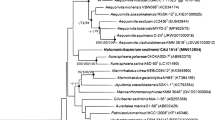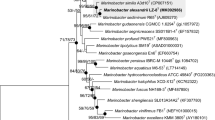Abstract
Two yellow-pigmented bacterial strains, LZ-14 T and ABI-LZ29, were isolated from the cultivable phycosphere microbiota of the highly toxic marine dinoflagellate Alexandrium catenella LZT09 and demonstrated obvious microalgae growth-promoting potentials toward the algal host. To elucidate the taxonomic status of the two bioactive bacterial strains, they were subjected to a polyphasic taxonomic characterization. Both strains were found to be Gram-negative, aerobic, rod-shaped and motile; to contain Q-10 as the predominant ubiquinone; summed feature 8, C16:0, C18:1 ω7c 11-methyl and summed feature 3 as the major fatty acids; and diphosphatidylglycerol, phosphatidylcholine, phosphatidylethanolamine, phosphatidylglycerol and two unidentified phospholipids as the predominant polar lipids. Based on the phylogenetic analysis, phylogenomic inferences and phenotypic characteristics, the strains could be clearly distinguished from phylogenetically closely related species and formed a distinct monophyletic lineage in the family Rhodobacteraceae. The size of the draft genome of strain LZ-14 T is 4.615 Mb, with a DNA G + C content of 63.3 mol%. It contains ten predicted secondary metabolite biosynthetic gene clusters and core genes for bacterial exopolysaccharide biosynthesis. Therefore, strain LZ-14 T (= CCTCC AB 2017230 T = KCTC 62342 T) represents a novel species of a new genus, for which the name Alexandriicola marinus gen. nov., sp. nov., is proposed.




Similar content being viewed by others
Data availability
All data have been made fully available to the public.
Abbreviations
- AAI:
-
Average amino acid identity
- ABI:
-
Algae-bacteria interactions
- ANI:
-
Average nucleotide identity
- dDDH:
-
Digital DNA-DNA hybridization
- GL:
-
Glycolipids
- MA:
-
Marine agar
- MB:
-
Marine broth
- MEGA:
-
Molecular evolutionary genetics analysis
- ML:
-
Maximum likelihood
- MP:
-
Maximum parsimony
- NJ:
-
Neighbour joining
- POCP:
-
Percentage of conserved proteins
- TLC:
-
Thin-layer chromatography
- UBCG:
-
Up-to-date bacterial core gene
References
Amin SA, Parker MS, Armbrust EV (2012) Interactions between diatoms and bacteria. Microbiol Mol Biol Rev 76:667–684
Bernardet JF, Nakagawa Y, Holmes B (2002) Proposed minimal standards for describing new taxa of the family Flavobacteriaceae and emended description of the family. Int J Syst Evol Microbiol 52:1049–1070
Blin K, Pascal Andreu V, de Los Santos ELC, Del Carratore F, Lee SY, Medema MH, Weber T (2019) The antiSMASH database version 2: a comprehensive resource on secondary metabolite biosynthetic gene clusters. Nucleic Acids Res 47:D625–D630
Chun J, Oren A, Ventosa A, Christensen H, Arahal DR, da Costa MS, Rooney AP, Yi H, Xu XW, De Meyer S, Trujillo ME (2018) Proposed minimal standards for the use of genome data for the taxonomy of prokaryotes. Int J Syst Evol Microbiol 68:461–466
Connon SA, Giovannoni SJ (2002) High-throughput methods for culturing microorganisms in very-low-nutrient media yield diverse new marine isolates. Appl Environ Microbiol 68:3878–3885
Duan Y, Jiang Z, Wu Z, Sheng Z, Yang X, Sun J, Zhang X, Yang Q, Yu X, Yan J (2020) Limnobacter alexandrii sp. nov., a thiosulfate-oxidizing, heterotrophic and EPS-bearing Burkholderiaceae isolated from cultivable phycosphere microbiota of toxic Alexandrium catenella LZT09. Antonie Van Leeuwenhoek 113:1689–1698
Ezaki T, Hashimoto Y, Yabuuchi E (1989) Fluorometric deoxyribonucleic acid-deoxyribonucleic acid hybridization in microdilution wells as an alternative to membrane filter hybridization in which radioisotopes are used to determine genetic relatedness among bacterial strains. Int J Syst Bacteriol 39:224–229
Gao HM, Xie PF, Zhang XL, Yang Q (2021) Isolation, phylogenetic and gephyromycin metabolites characterization of new exopolysaccharides- bearing antarctic actinobacterium from faeces of emperor penguin. Mar Drugs 19:458
Garrity GM, Bell JA, Lilburn T (2005) Family I. Rhodobacteraceae fam. nov. In: Brenner DJ, Krieg NR, Staley JT, Garrity GM (eds.) Bergey's Manual of Systematic Bacteriology, 2nd edn, vol. 2 (The Proteobacteria), part C (The Alpha-, Beta-, Delta-, and Epsilonproteobacteria), Springer, New York, p 161
Giovannoni SJ, Nemergut D (2014) Microbes ride the current. Science 345:1246
Hiraishi A, Ueda Y, Ishihara J, Mori T (1996) Comparative lipoquinone analysis of inflfluent sewage and activated sludge by high-performance liquid chromatography and photodiode array detection. J Gen Appl Microbiol 42:457–469
Huang MM, Guo LL, Wu YH, Lai QL, Shao ZZ, Wang CS, Wu M, Xu XW (2018) Pseudooceanicola lipolyticus sp. nov., a marine alphaproteobacterium, reclassification of Oceanicola flagellatus as Pseudooceanicola flagellatus comb. nov. and emended description of the genus Pseudooceanicola. Int J Syst Evol Microbiol 68:409–415
Kates M (1986) Lipid extraction procedures. In: Burdun RH, van Knippenberg PH (eds) Laboratory Techniques in Biochemistry and Molecular Biology. Elsevier, Amsterdam, pp 350–351
Kumar S, Stecher G, Tamura K (2016) MEGA7: molecular evolutionary genetics analysis version 7.0 for bigger datasets. Mol Biol Evol 33:1870–1874
Lai Q, Li G, Liu X, Du Y, Sun F, Shao Z (2015) Pseudooceanicola atlanticus gen. nov. sp. nov., isolated from surface seawater of the Atlantic Ocean and reclassification of Oceanicola batsensis, Oceanicola marinus, Oceanicola nitratireducens, Oceanicola nanhaiensis, Oceanicola antarcticus and Oceanicola flagellatus, as Pseudooceanicola batsensis comb. nov., Pseudooceanicola marinus comb. nov., Pseudooceanicola nitratireducens comb. nov., Pseudooceanicola nanhaiensis comb. nov., Pseudooceanicola antarcticus comb. nov., and Pseudooceanicola flagellatus comb. nov. Antonie Van Leeuwenhoek 107:1065–1074
Landry ZC, Vergin K, Mannenbach C, Block S, Yang Q, Blainey P, Carlson C, Giovannoni S (2018) Optofluidic single-cell genome amplification of sub-micron bacteria in the ocean subsurface. Front Microbiol 9:1152
Liang KYH, Orata FD, Boucher YF, Case RJ (2021) Roseobacters in a Sea of Poly- and Paraphyly: Whole Genome-Based Taxonomy of the Family Rhodobacteraceae and the Proposal for the Split of the “Roseobacter Clade” Into a Novel Family, Roseobacteraceae fam. nov. Front Microbiol 12:683109
Meier-Kolthoff JP, Auch AF, Klenk HP, Göker M (2013) Genome sequence-based species delimitation with confidence intervals and improved distance functions. BMC Bioinf 14:60
Na SI, Kim YO, Yoon SH, Ha SM, Baek I, Chun J (2018) UBCG: up-to-date bacterial core gene set and pipeline for phylogenomic tree reconstruction. J Microbiol 56:281–285
Richter M, Rosselló-Móra R (2009) Shifting the genomic gold standard for the prokaryotic species definition. Proc Natl Acad Sci US 106:19126–19131
Sasser M (1990) Identification of Bacteria by Gas Chromatography of Cellular Fatty Acids, MIDI Technical Note 101. Newark, DE: MIDI
Simon M, Scheuner C, Meier-Kolthoff JP, Brinkhoff T, Wagner-Döbler I, Ulbrich M, Klenk HP, Schomburg D, Petersen J, Göker M (2017) Phylogenomics of Rhodobacteraceae reveals evolutionary adaptation to marine and non-marine habitats. ISME J 11:1483–1499
Wang X, Ye Y, Xu FF, Duan YH, Xie PF, Yang Q, Zhang X (2021) Maritimibacter alexandrii sp. nov., a New Member of Rhodobacteraceae Isolated from Marine Phycosphere. Curr Microbiol 78:3996–4003
Wirth JS, Whitman WB (2018) Phylogenomic analyses of a clade within the roseobacter group suggest taxonomic reassignments of species of the genera Aestuariivita, Citreicella, Loktanella, Nautella, Pelagibaca, Ruegeria, Thalassobius, Thiobacimonas and Tropicibacter, and the proposal of six novel genera. Int J Syst Evol Microbiol 68:2393–2411
Yang Q, Jiang Z, Zhou X, Xie Z, Wang Y, Wang D, Feng L, Yang G, Ge Y, Zhang X (2020a) Saccharospirillum alexandrii sp. nov., isolated from the toxigenic marine dinoflagellate Alexandrium catenella LZT09. Int J Syst Evol Microbiol 70:820–826
Yang Q, Jiang Z, Zhou X, Zhang R, Wu Y, Lou L, Ma Z, Wang D, Ge Y, Zhang X, Yu X (2020b) Nioella ostreopsis sp. nov., isolated from toxic dinoflagellate, Ostreopsis lenticularis. Int J Syst Evol Microbiol 70:759–765
Yang Q, Jiang Z, Zhou X, Zhang R, Xie Z, Zhang S, Wu Y, Ge Y, Zhang X (2020c) Haliea alexandrii sp. nov., isolated from phycosphere microbiota of the toxin-producing dinoflagellate Alexandrium catenella. Int J Syst Evol Microbiol 70:1133–1138
Yang X, Jiang ZW, Zhang J, Zhou X, Zhang XL, Wang L, Yu T, Wang Z, Bei J, Dong B (2020d) Mesorhizobium alexandrii sp. nov., isolated from phycosphere microbiota of PSTs-producing marine dinoflagellate Alexandrium minutum amtk4. Antonie Van Leeuwenhoek 113:907–917
Yang Q, Feng Q, Zhang BP, Gao JJ, Sheng Z, Xue QP, Zhang XL (2021a) Marinobacter alexandrii sp. nov., a novel yellow-pigmented and algae growth-promoting bacterium isolated from marine phycosphere microbiota. Antonie Van Leeuwenhoek 114:709–718
Yang Q, Ge YM, Iqbal NM, Yang X, Zhang XL (2021b) Sulfitobacter alexandrii sp. nov., a new microalgae growth-promoting bacterium with exopolysaccharides bioflocculanting potential isolated from marine phycosphere. Antonie Van Leeuwenhoek 114:1091–1106
Yoon JH, Kang SJ, Lee SY, Jung YT, Lee JS, Oh TK (2012) Marivita hallyeonensis sp. nov., isolated from seawater, reclassification of Gaetbulicola byunsanensis as Marivita byunsanensis comb. nov. and emended description of the genus Marivita Hwang et al. 2009. Int J Syst Evol Microbiol 62:839–843
Zhang XL, Ma LY, Tian XQ, Huang HL, Yang Q (2015) Biodiversity study of intracellular bacteria closely associated with paralytic shellfish poisoning dinoflagellates Alexandrium tamarense and A. minutum. Int J Env Resour 4:23–27
Zhang XL, Yang X, Wang SJ, Jiang JW, Xie ZX, Zhang L, Dai J, Fan CQ, Tian XQ, Yang Q (2020) Draft genome sequences of nine cultivable heterotrophic proteobacteria isolated from phycosphere microbiota of toxic Alexandrium catenella LZT09. Microbiol Resour Announc 9:e00281-e320
Zhang XL, Li GX, Ge YM, Iqbal MN, Yang X, Cui ZD, Yang Q (2021a) Sphingopyxis microcytisis sp. nov., a novel bioactive exopolysaccharides-bearing Sphingomonadaceae isolated from the Microcytis phycosphere. Antonie Van Leeuwenhoek 114:845–857
Zhang XL, Qi M, Li QH, Cui ZD, Yang Q (2021b) Maricaulis alexandrii sp. nov., a novel active bioflocculants-bearing and dimorphic prosthecate bacterium isolated from marine phycosphere. Antonie Van Leeuwenhoek 78:1648–1655
Zhou X, Zhang XA, Jiang ZW, Yang X, Zhang XL, Yang Q (2021) Combined characterization of a new member of Marivita cryptomonadis, strain LZ-15-2 isolated from cultivable phycosphere microbiota of toxic HAB dinoflagellate Alexandrium catenella LZT09. Braz J Microbiol 52:739–748
Zhu WZ, Ge YM, Gao HM, Dai J, Zhang XL, Yang Q (2021) Gephyromycinifex aptenodytis gen. nov., sp. nov., isolated from gut of Antarctic emperor penguin. Antonie Van Leeuwenhoek 114:2003–2017
Zhu WZ, Wang SH, Gao HM, Ge YM, Dai J, Zhang XL, Yang Q (2022) Characterization of Bioactivities and Biosynthesis of Angucycline/Angucyclinone Derivatives Derived from Gephyromycinifex aptenodytis gen. nov., sp nov. Mar Drugs 20:34
Acknowledgements
The authors acknowledge Prof. Aharon Oren at The Hebrew University of Jerusalem for providing useful advice for naming the new bacterium.
Funding
This work was supported by the Fundamental Research Funds for Zhejiang Provincial Universities and Research Institutes (2021J020), the National Natural Science Foundation of China (41876114), the Specific Project for Zhejiang Ocean University from Municipal Science and Technology Bureau of Zhoushan (2022C41018, 20210198), and the Scientific Research Startup Foundation of Zhejiang Ocean University (11104150319/001), and Special Fund for Scientific Innovation Strategy-construction of High Level Academy of Agriculture Science-Distinguished Scholar (2020PY-JC001).
Author information
Authors and Affiliations
Contributions
QY and XZ conceived the project. WZ, HG, YG and XY performed the experiments, WZ, HG, YG, JD, and XY analyzed the data, and XZ and QY drafted and revised the manuscript. All authors have read and approved the final version of the manuscript.
Corresponding authors
Ethics declarations
Conflict of interest
All the authors have declared no conflict of interest.
Consent to participate
All authors gave their consent to participate in this study.
Additional information
Publisher's Note
Springer Nature remains neutral with regard to jurisdictional claims in published maps and institutional affiliations.
Supplementary Information
Below is the link to the electronic supplementary material.
Rights and permissions
About this article
Cite this article
Zhu, WZ., Gao, HM., Ge, YM. et al. Alexandriicola marinus gen. nov., sp. nov., a new member of the family Rhodobacteraceae isolated from marine phycosphere. Antonie van Leeuwenhoek 115, 473–486 (2022). https://doi.org/10.1007/s10482-022-01710-2
Received:
Accepted:
Published:
Issue Date:
DOI: https://doi.org/10.1007/s10482-022-01710-2




